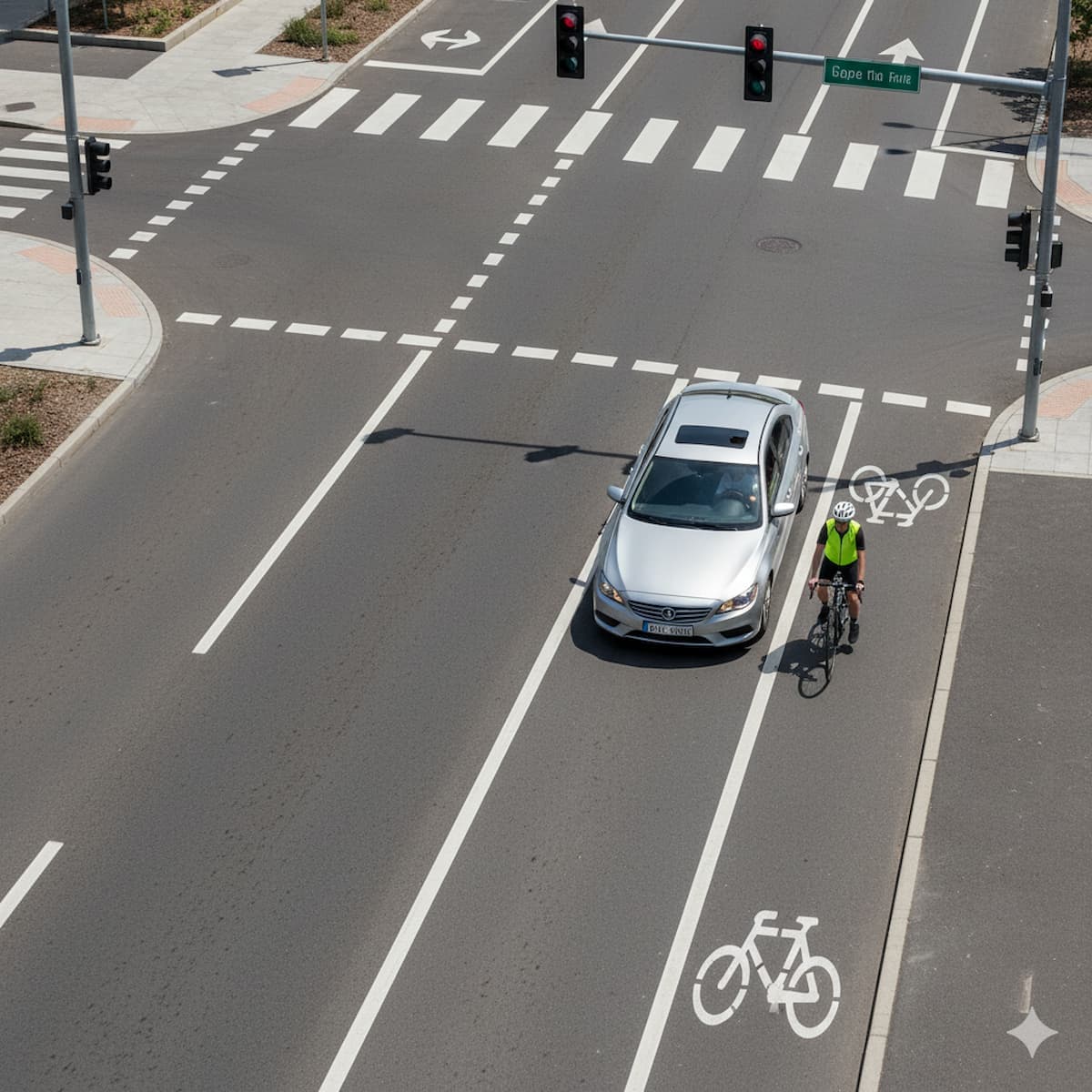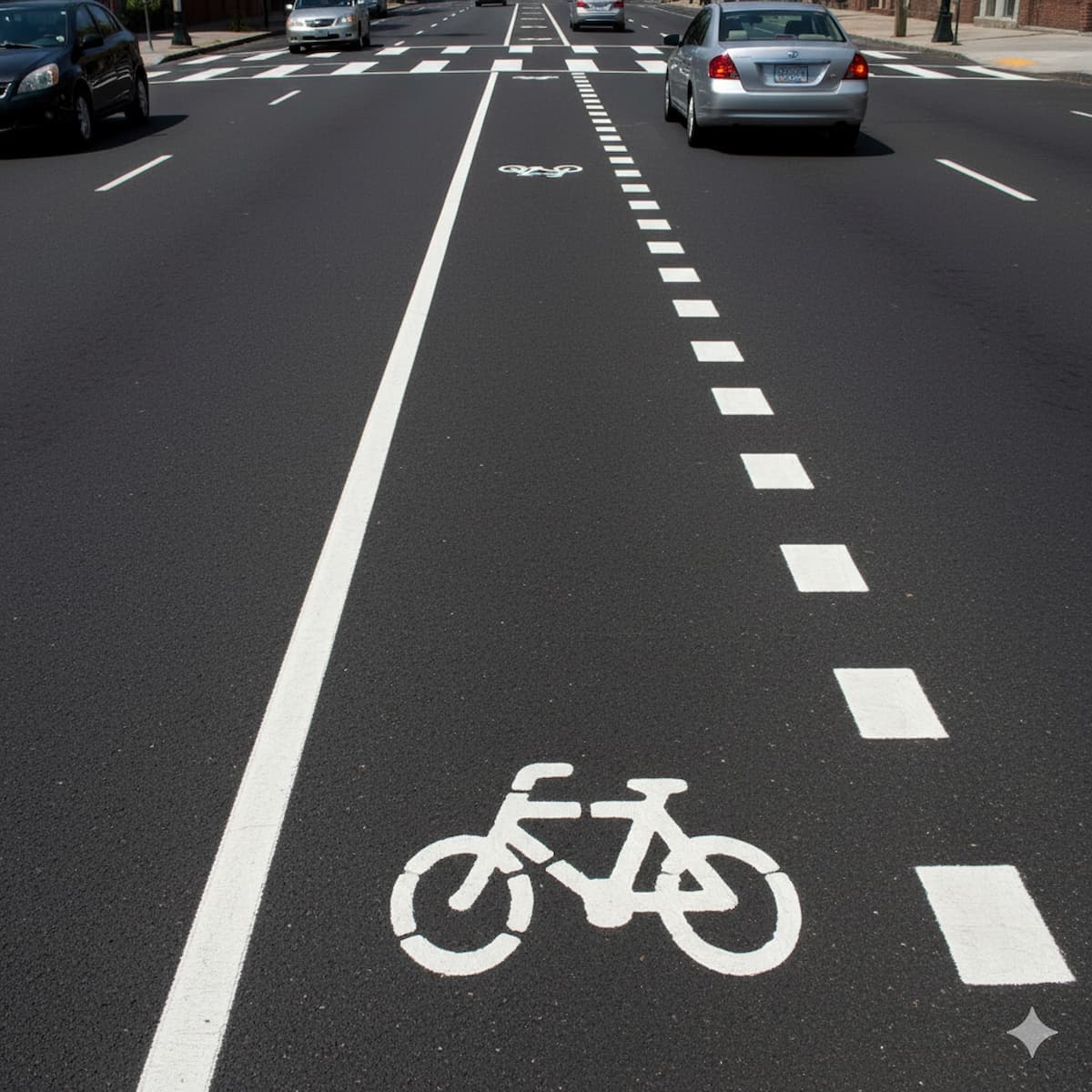
When you may merge across a bike lane for a right turn
Most U.S. states allow drivers to merge across a solid white bike lane line to prepare for a right turn, typically within 200 feet of the intersection. The key requirement: you must yield to any cyclists already in the bike lane before merging. Many urban areas mark dashed merge segments near intersections—these dashed lines explicitly signal where merging is permitted and expected.
This practice is designed to prevent dangerous right-hook crashes, where a driver turns right across the path of a cyclist traveling straight in the bike lane. By merging into the bike lane before the turn (when safe and legal), you eliminate the conflict zone and make your intentions clear to cyclists behind you.
Yield to cyclists and avoid right-hook conflicts
Before you merge into any bike lane, perform a thorough safety check:
- Mirror check: Glance at your right side mirror to detect approaching cyclists.
- Shoulder check: Turn your head to eliminate the blind spot—cyclists can appear quickly.
- Wait for a clear gap: If a cyclist is present or approaching, wait until they pass completely. Never cut in front of them.
- Signal continuously: Keep your right turn signal active from at least 100 feet before the turn through completion.
Right-hook crashes are one of the most common bike-car collision types. The cyclist is traveling straight; the driver, focused on cross-traffic or pedestrians, turns right without seeing the cyclist. Following proper merge and yield procedures dramatically reduces this risk.
Signal timing and shoulder check best practices
Effective signaling and awareness are your primary tools for preventing conflicts:
- Signal early: Activate your turn signal at least 100 feet (about 3 seconds of travel) before the turn. This gives cyclists time to anticipate your movement.
- Reduce speed gradually: Slow down smoothly as you approach the turn, allowing cyclists to gauge your intentions.
- Shoulder check twice: Check once before merging and again immediately before turning. Cyclists can accelerate or appear in your blind spot.
- Make eye contact when possible: If you see a cyclist, brief eye contact confirms mutual awareness.
Urban paint patterns: dashed merge segments
In many cities, bike lane lines transition from solid white to dashed white as you approach an intersection. These dashed segments (typically 50–200 feet long) serve as designated merge zones. When you see dashed lines, the roadway design is explicitly inviting drivers to merge into the bike lane (after yielding) to prepare for right turns.
Even where dashed segments are not present, most state vehicle codes allow merging across a solid bike lane line within a reasonable distance of your turn (commonly 200 feet). However, always check for local signs or painted symbols that may restrict merging—some protected bike lanes prohibit motor vehicle entry entirely.

Ticket scenarios for bike-lane encroachment
Common violations and their consequences:
- Turning right without merging (from the through lane): Some jurisdictions require you to merge into the bike lane before turning. Failing to do so may result in an improper-turn citation and a typical fine of $100–$250.
- Merging without yielding: Cutting off a cyclist can lead to a failure-to-yield ticket, points on your license, and potential liability if a crash occurs.
- Driving in the bike lane for through travel: Bike lanes are not general-purpose lanes. Using them to bypass traffic or as parking can result in fines ($200+ in many cities) and points.
- Blocking the bike lane: Stopping or parking in a bike lane (except for emergencies or loading zones where permitted) often incurs immediate fines and possible towing.
Right-turn pocket and bike lane configurations
Some intersections feature a dedicated right-turn-only lane that is separate from the bike lane. In these configurations, the bike lane typically continues straight to the left of the turn pocket. Your job is simpler: stay in the turn lane, and watch for cyclists who may be crossing through the intersection to your left.
Where no separate turn pocket exists, the standard practice applies: merge into the bike lane (yielding first) and turn from the rightmost position to prevent cyclists from being squeezed between your vehicle and the curb.
When you must not cross the solid line of a bike lane
Despite the general permission to merge for turns, certain situations prohibit crossing into a bike lane:
Protected or separated bike lanes
Protected bike lanes (also called separated or buffered bike lanes) use physical barriers—planters, plastic posts, curbs, or wide painted buffers—to separate cyclists from motor traffic. These lanes often feature double solid white lines or a hatched buffer zone. Do not cross into protected bike lanes unless there is a designated opening or driveway access point. Signs and pavement markings will indicate where crossings are permitted.
No-merge zones and signed restrictions
Watch for regulatory signs that explicitly prohibit entering the bike lane:
- "DO NOT CROSS BIKE LANE" signs
- Red curb or no-stopping zones adjacent to bike lanes
- Bike lane symbols with diamonds or other pavement markings indicating continuous priority for cyclists
In these areas, you must turn right from the general travel lane, yielding to cyclists who have the right-of-way to continue straight. This setup is less common but appears in high-volume bike corridors.
Using bike lanes for through travel or passing
Bike lanes are reserved for bicycles and, in some jurisdictions, other non-motorized or low-speed vehicles. You may not:
- Drive in a bike lane to bypass congestion
- Use a bike lane as a passing lane
- Park or idle in a bike lane (except in designated loading zones during permitted hours)
Violations typically result in fines starting at $150–$300, with higher penalties in some urban areas. Repeat offenders may face license points and increased insurance premiums.
Emergency vehicles and bike lane usage
Emergency vehicles (police, fire, ambulance) may use bike lanes when responding to emergencies. As a civilian driver, you should not follow emergency vehicles into bike lanes. Pull to the right and stop in the general travel lane to allow emergency vehicles to pass, but do not encroach into the bike lane yourself unless you are preparing for a legal turn.
State and local bike lane crossing rules
Bike lane regulations vary by state and municipality. Below are quick summaries and links to detailed state-specific guides:
California: dashed segments and 200-foot rule
California Vehicle Code § 21717 allows drivers to cross bike lane lines to turn right or enter/exit the roadway, provided they yield to cyclists and the maneuver is safe. Many California cities use dashed merge segments starting 50–200 feet before intersections. See California bike lane rules for citations and local variations.
New York: protected lanes and no-merge signage
New York City and other urban areas feature extensive protected bike lane networks. Many of these lanes prohibit motor vehicle entry except at marked driveways. Always look for "DO NOT BLOCK BIKE LANE" and "NO STANDING ANYTIME" signs. Fines for bike lane violations in NYC start at $115 and can exceed $175 for repeat offenses. See New York bike lane regulations.
Texas: yield and merge principles
Texas Transportation Code § 545.301 requires drivers to merge into the rightmost lane before turning right. Where a bike lane is present, this generally means merging into the bike lane (after yielding) before completing the turn. Urban areas like Austin and Houston use dashed merge segments. See Texas bike lane rules.
Florida: caution in high-bike-volume areas
Florida law (§ 316.2065) requires drivers to yield to cyclists and pedestrians. While merging into bike lanes for turns is generally permitted, many Florida beach towns and university areas have high cyclist traffic—exercise extra caution and expect cyclists year-round. See Florida bike lane rules.
Washington and Oregon: progressive bike infrastructure
Cities like Seattle and Portland feature advanced bike lane designs, including bike boxes, two-stage turn queues, and protected intersections. Familiarize yourself with local pavement markings—green-painted bike lanes, for example, indicate conflict zones where extra caution is required. Washington rules | Oregon rules.
Best practices for drivers and cyclists sharing the road
Safe roadway sharing requires mutual respect and awareness. Here are practical tips for drivers:
For drivers: predictability and patience
- Signal every time: Even if no cyclists are visible, consistent signaling builds good habits and warns cyclists who may approach quickly.
- Slow down near bike lanes: Reduced speed gives you more time to react and makes your intentions clear.
- Leave space when passing parked cars: Cyclists often ride toward the left edge of the bike lane to avoid "dooring" (car doors opening into their path). Give them room.
- Watch for bike signals and hand gestures: Cyclists signal turns and stops with hand signals—learn to recognize them.
- Be patient at intersections: If a cyclist is waiting at a red light in the bike lane, do not squeeze alongside. Wait behind them or merge into the bike lane legally (if turning) after they proceed.
For cyclists: visibility and defensive riding
While this guide focuses on driver responsibilities, cyclists can enhance safety by:
- Using lights and reflectors: Front white light and rear red light are required at night in most states.
- Riding predictably: Hold a straight line, signal turns, and avoid sudden swerves.
- Making eye contact: Confirm that drivers see you before proceeding through intersections.
- Positioning strategically: Ride in the center of the bike lane near intersections to remain visible and discourage unsafe right hooks.
Shared responsibility and legal accountability
Both drivers and cyclists have legal duties to operate safely and follow traffic laws. Drivers are required to yield when merging into bike lanes; cyclists must obey traffic signals, use lights at night, and ride in the same direction as traffic. In crash investigations, fault is determined by adherence to these rules—violations by either party can affect liability and insurance claims.